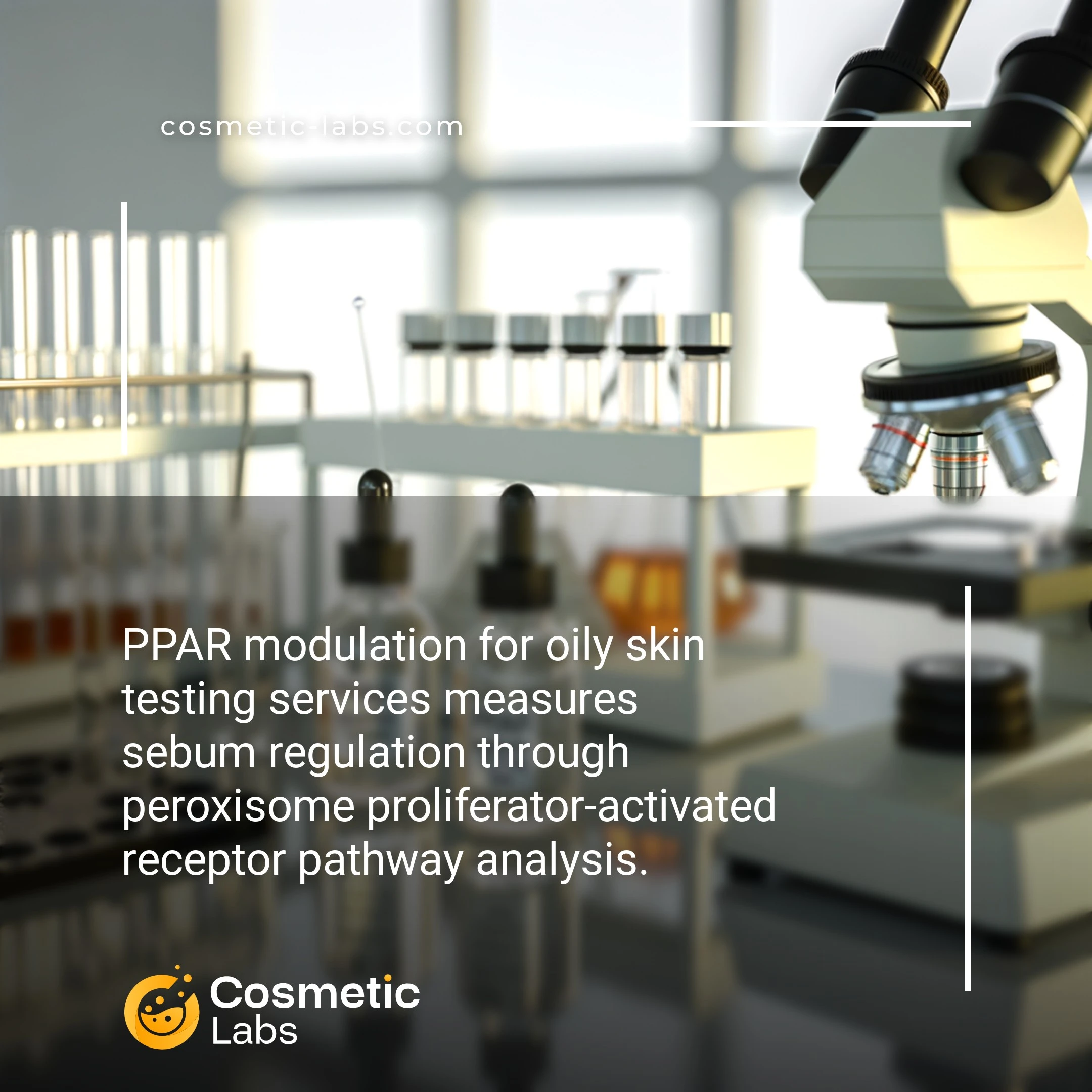PPAR Modulation Testing Services for Oily Skin Formulations

What is PPAR modulation?
PPAR modulation testing for oily skin measures how cosmetic ingredients influence peroxisome proliferator-activated receptors that control sebum production and skin barrier function. Labs use in vitro sebocyte cultures and lipid analysis to evaluate how formulations affect PPAR-gamma activity, which directly regulates oil gland behavior. This testing reveals whether your anti-acne or mattifying ingredients actually reduce excess sebum at the cellular level, not just surface appearance.
Why do you need this service?
Cosmetic labs use PPAR modulation testing to validate sebum-regulating ingredients in anti-acne serums and mattifying moisturizers before market launch. Teams measure sebaceous gland activity reduction and pore size changes through specialized assays, delivering quantifiable efficacy data that supports product claims and regulatory submissions for oily skin formulations.
Who provides PPAR modulation services?
All cosmetic labs providing PPAR modulation services
There is no company providing these services at the moment.
PPAR Modulation Testing for Oily Skin Formulations
PPAR modulation testing helps cosmetic labs validate how your formulations regulate sebum production through peroxisome proliferator-activated receptor pathways. This preclinical testing approach measures your product’s ability to balance oil production at the cellular level, providing data you need for oily skin claims.
Sebocyte Culture Testing Methods
Labs use human sebocyte cultures to test how your ingredients affect PPAR-gamma activation and lipid synthesis. These in-vitro models replicate sebaceous gland function, measuring sebum production changes after ingredient exposure. Testing typically runs 72-96 hours with multiple concentration points.
Key measurements include:
- Lipid droplet formation analysis
- Sebum production quantification
- Gene expression profiling for PPAR targets
- Cytotoxicity assessment at test concentrations
Molecular Pathway Analysis
Advanced labs run RT-PCR analysis to measure PPAR-gamma, SREBP-1, and ACC gene expression changes. This molecular approach shows exactly how your formulation affects the sebum production cascade. Results help you understand ingredient mechanisms and optimize concentrations.
Testing protocols examine:
- PPAR-gamma receptor binding affinity
- Downstream enzyme activity changes
- Inflammatory marker modulation
- Dose-response relationships for active ingredients
Connect with specialized labs on our platform to discuss PPAR modulation testing for your oily skin formulations and get detailed protocols tailored to your product development needs.
Applications of PPAR Modulation Testing for Oily Skin Products
PPAR modulation testing applications enable cosmetic brands to validate sebum regulation claims and develop targeted treatments for oily skin conditions through precise molecular pathway analysis.
Sebum Production Control Validation
Labs use PPAR-gamma and PPAR-alpha pathway testing to measure how active ingredients affect sebaceous gland activity. This testing validates claims about oil control, pore size reduction, and shine management in formulations containing niacinamide, retinoids, or zinc compounds.
Testing protocols measure sebum production rates before and after ingredient exposure using sebocyte cell cultures. Results typically show 15-40% reduction in lipid synthesis within 72-hour test periods, providing quantifiable data for product positioning and regulatory submissions.
Anti-Inflammatory Efficacy Assessment
PPAR modulation testing evaluates how ingredients reduce inflammatory responses in oily, acne-prone skin. Labs test botanical extracts, peptides, and synthetic compounds for their ability to activate PPAR pathways that suppress inflammatory cytokine production.
Testing measures IL-1β, TNF-α, and IL-6 levels in treated keratinocyte cultures. Effective ingredients show 20-60% reduction in inflammatory markers, supporting claims about acne prevention and skin barrier repair. This data strengthens product differentiation in competitive oily skin markets.
| PPAR Pathway | Primary Function | Testing Timeframe | Measurable Outcomes |
|---|---|---|---|
| PPAR-α | Sebum regulation | 48-72 hours | 15-40% lipid reduction |
| PPAR-γ | Anti-inflammatory | 24-48 hours | 20-60% cytokine reduction |
| PPAR-δ | Barrier function | 72-96 hours | 25-50% barrier improvement |
Ready to validate your oily skin formulations with PPAR modulation testing? Contact specialized cosmetic labs on our platform to discuss your specific testing requirements and claim substantiation goals.
